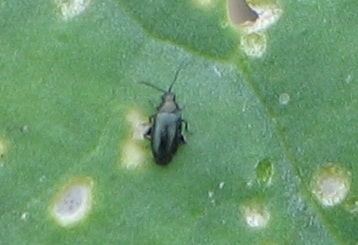
When scouting for insects, for example, go out with an eye for any possibility. Look above ground. Dig below ground. Look at what’s flying. Try walking through ditches to see what’s there. You’ll likely see more activity when the weather is sunny and warm versus cool and wet.
The Prairies haven’t had any widespread insect outbreaks yet this year, but there are pockets where growers have had to spray for flea beetles and cutworms. Some locations where striped flea beetles were more common earlier now have crucifer flea beetles in big numbers. Wireworms may also be feeding, but sprays don’t work on them. And in some rare cases, diamondback moth larvae are feeding on young canola plants.
Consider all possible causes when you notice uneven emergence, patchy growth and unthrifty plants. Get a second opinion when necessary. You need to know what caused a problem before you can take effective corrective action.
Here are a few things to look for:
Differences row by row. Are some rows good and others thin? Or does it seems like strips of rows are poor while the rest are OK? These are likely the result of drill malfunction, or seeding too fast, with rear openers burying the front rows too deep. Check for seed depth and placement. Identifying these issues now will allow you to make adjustments and replace worn components to help improve drill performance for next year.
Low emergence overall. If low emergence is fairly general throughout the field, seed may have been placed too deep, seeding rate may have been too low or seed quality was compromised. Large seed size combined with lower seeding rate and low seedling survival can result in thin stands. Estimate your actual percent seed survival (based on seeds planted versus seeds emerged) and consider this for next year.
Uneven growth staging. Large plants interspersed with late-emerging small plants can result from inconsistent seed depth from seed to seed. High fan speed on the drill may have caused seed bounce, which results in inconsistent seed placement. Worn openers and uneven residue cover are other possible factors.
Bald patches. Blank areas in the field can result from dry seedbeds, heavy winds, drowned plants, seed rots, cutworms and other insects, and from gophers.
Unthrifty, yellow or malformed plants. Unhealthy-looking plants can result from seedling diseases, herbicide carryover, herbicide burn, high rates of seed-placed fertilizer, fertilizer deficiency, low vigor and deep seeding, to name a few. Malformed plants can result from herbicide injury or disease, but possibly other factors.
Damaged plants. Environmental stresses such as frost or hail are possible reasons. Look for insects, particularly flea beetles and cutworms, but also wireworms and early grasshoppers. Even if you don’t see obvious feeding on leaves, look under the leaves and on stems. If flea beetles have moved down the plant due to rain or wind, they can actually do more damage. Severing a stem is far worse than 25% damage on the leaf. Check leaves for blackleg lesions.
While doing the above ground scan, look at the weeds. What type, size and number do you see? This will help determine whether another spray is warranted and what tank mix and rate to use.
After the above-ground assessment, get a trowel and bucket and start digging around damaged plants. Look for cutworms and wireworms in the top 4” of soil. Look at the roots for signs of insect feeding or disease damage. Chomped roots are usually insect damage. Mushy or thin wiry roots and stems are often the result of seedling disease.
